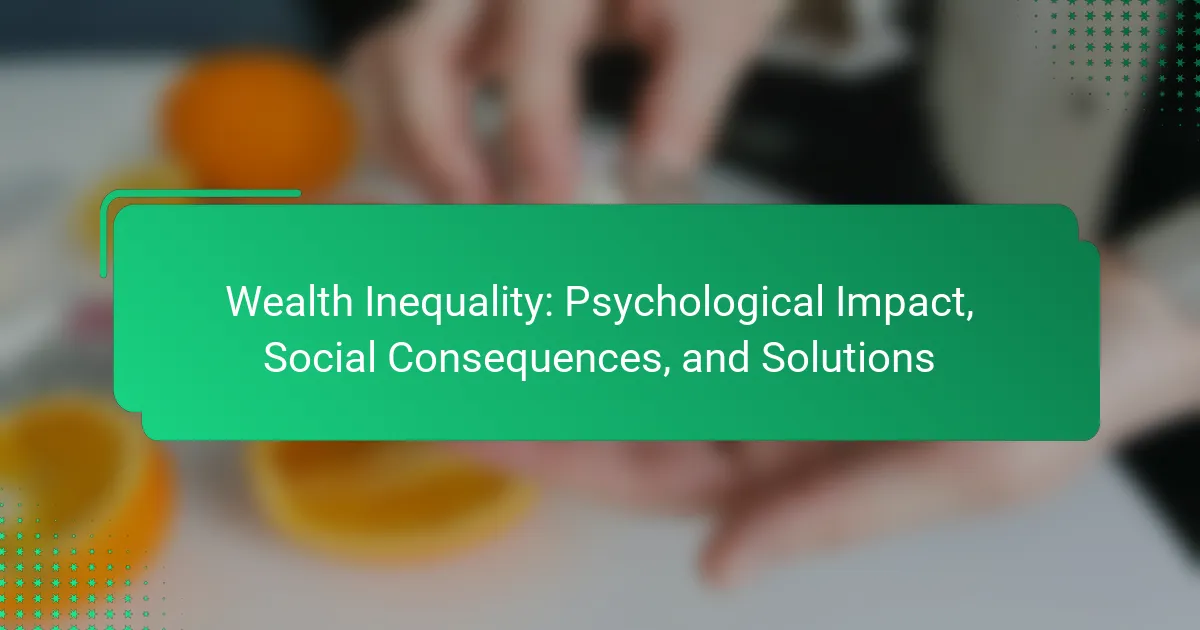Wealth inequality affects psychological well-being, leading to anxiety and depression. It results in social consequences like increased crime and reduced community trust. Unique attributes reveal how wealth concentration impacts mental health and social mobility. Effective solutions include progressive taxation and improved access to education and healthcare.
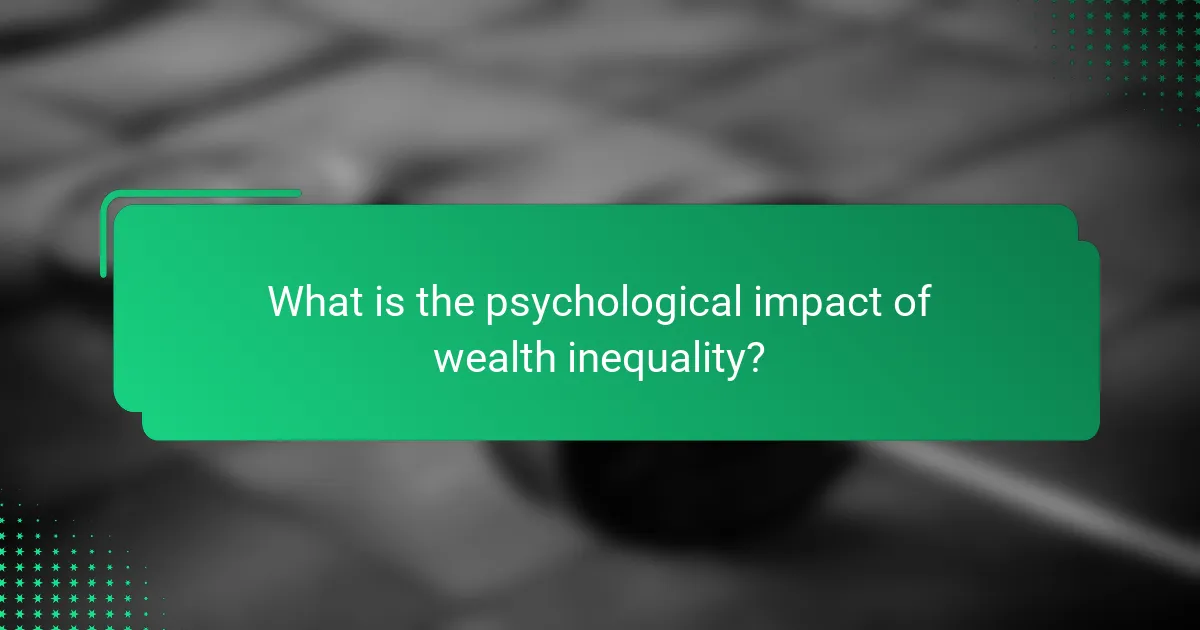
What is the psychological impact of wealth inequality?
Wealth inequality significantly affects psychological well-being, leading to increased anxiety, depression, and feelings of inferiority. Research indicates that individuals in economically disadvantaged positions often experience lower self-esteem and higher stress levels. This disparity can create social tension, contributing to a sense of disconnection within communities. As a result, addressing wealth inequality is crucial for improving overall mental health and fostering social cohesion.
How does wealth inequality affect mental health?
Wealth inequality negatively impacts mental health by increasing stress, anxiety, and feelings of inadequacy. Individuals in lower socioeconomic positions often experience social exclusion and reduced access to mental health resources. Studies indicate that wealth disparities correlate with higher rates of depression and anxiety disorders. As a result, addressing wealth inequality can lead to improved mental health outcomes across communities.
What are the feelings of stress and anxiety associated with wealth disparity?
Wealth disparity often leads to feelings of stress and anxiety among individuals. These emotions arise from perceived social injustice and the struggle for resources. Studies show that individuals in lower socioeconomic statuses frequently experience heightened anxiety due to financial insecurity. Additionally, the stress manifests in physical health issues, affecting overall well-being. As a result, addressing wealth inequality is crucial for improving mental health outcomes in affected populations.
What role does social comparison play in psychological outcomes?
Social comparison significantly influences psychological outcomes related to wealth inequality. Individuals often evaluate their self-worth based on their financial status relative to others. This can lead to feelings of inadequacy, anxiety, and depression when they perceive themselves as less affluent. Research indicates that exposure to wealthier peers can exacerbate these negative emotions, fostering a sense of social exclusion. Conversely, positive social comparisons, where individuals identify with those of similar or lower economic status, can enhance self-esteem and resilience. Addressing these dynamics is crucial for promoting mental well-being in societies marked by economic disparities.
How does perceived social mobility influence psychological well-being?
Perceived social mobility significantly influences psychological well-being by shaping individuals’ expectations and feelings of control. When people believe they can improve their socio-economic status, they experience greater life satisfaction and motivation. Conversely, perceived stagnation can lead to anxiety and depression. Research indicates that communities with higher perceived mobility report better mental health outcomes. This underscores the importance of fostering environments that promote social mobility to enhance overall psychological well-being.
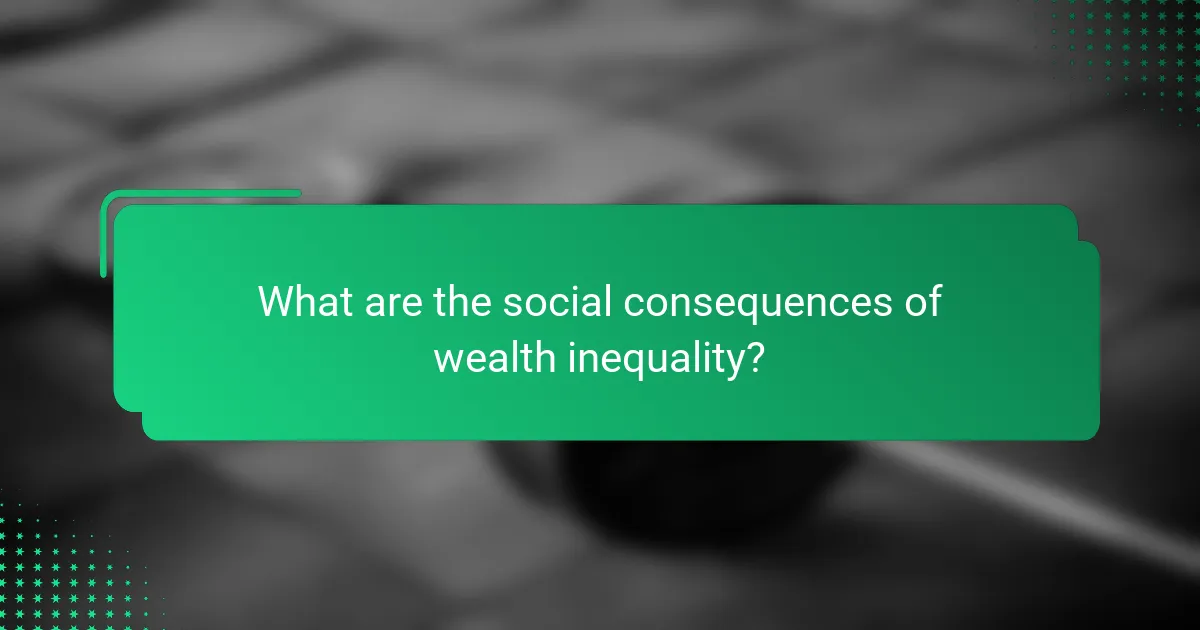
What are the social consequences of wealth inequality?
Wealth inequality leads to significant social consequences, including increased crime rates and reduced social cohesion. Research indicates that societies with higher wealth disparities often experience higher levels of mistrust among citizens. This lack of trust can hinder community engagement and collaboration. Additionally, wealth inequality can result in diminished access to education and healthcare for lower-income populations, perpetuating a cycle of poverty. As a result, social mobility decreases, further entrenching the divide between the wealthy and the poor.
How does wealth inequality contribute to social division?
Wealth inequality significantly contributes to social division by fostering resentment and diminishing social cohesion. This disparity creates psychological stress among lower-income groups, leading to feelings of disenfranchisement. As a result, communities become polarized, with wealthier individuals often isolating themselves from those with fewer resources. Studies indicate that high levels of inequality correlate with increased crime rates and reduced trust among community members. Addressing wealth inequality through policy reforms can mitigate these social consequences and promote a more unified society.
What are the implications for community cohesion?
Wealth inequality negatively impacts community cohesion by fostering distrust and division among social groups. Economic disparities lead to social isolation, reducing opportunities for interaction and collaboration. This fragmentation can result in increased crime rates and decreased civic engagement. As a result, communities may struggle to form a unified identity, hindering collective problem-solving efforts. Addressing wealth inequality can strengthen community ties and enhance overall social stability.
How does wealth inequality affect access to education and healthcare?
Wealth inequality significantly limits access to education and healthcare. Individuals from lower-income backgrounds face barriers such as high tuition fees and healthcare costs, resulting in reduced opportunities for advancement.
Research indicates that children in impoverished households are less likely to attend quality schools, which perpetuates the cycle of poverty. For instance, a study found that students from low-income families are 50% less likely to graduate from high school compared to their wealthier peers.
In healthcare, wealth disparity leads to unequal access to medical services. Those with lower income often lack health insurance, which restricts their ability to receive necessary treatments. A report highlighted that uninsured individuals are 3.5 times more likely to forgo medical care due to cost concerns.
Addressing wealth inequality through policy changes can improve access to both education and healthcare, fostering a more equitable society.
What role does wealth inequality play in crime rates and safety perceptions?
Wealth inequality significantly contributes to higher crime rates and alters safety perceptions. Socioeconomic disparities create environments of frustration and desperation, leading to increased criminal behavior. Research indicates that communities with pronounced wealth gaps often experience elevated levels of violence and property crimes. As a result, residents in these areas tend to feel less safe, fostering a cycle of fear and mistrust. Addressing wealth inequality through targeted policies can enhance community safety and improve perceptions of security.
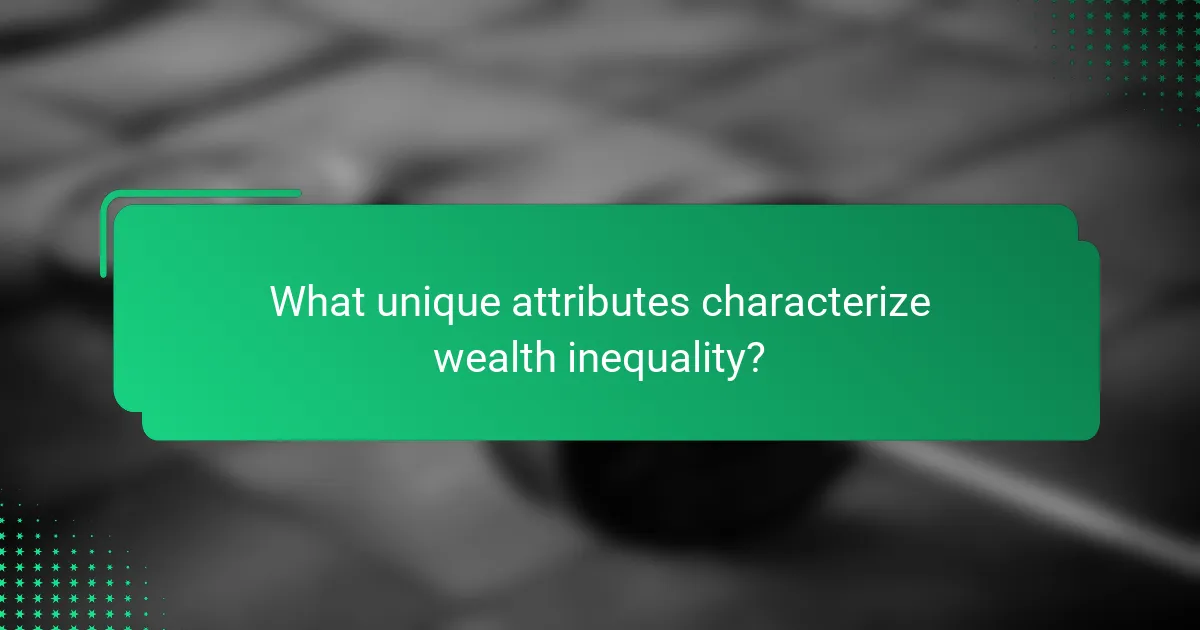
What unique attributes characterize wealth inequality?
Wealth inequality is characterized by distinct attributes such as disparity in income distribution, access to education, and opportunities for social mobility. These unique attributes reveal how wealth concentration impacts psychological well-being and societal cohesion. For instance, individuals in wealthier brackets often experience improved mental health outcomes compared to those in lower-income groups. Additionally, wealth inequality can lead to social unrest and decreased trust in institutions, further exacerbating the divide. Addressing these unique attributes is essential for developing effective solutions to mitigate wealth inequality.
How do cultural perceptions of wealth influence inequality?
Cultural perceptions of wealth significantly influence inequality by shaping attitudes towards success and resource distribution. Societies that glorify wealth often exacerbate disparities, creating a divide between the affluent and the poor. For instance, cultures that emphasize individual achievement may foster environments where wealth accumulation is prioritized, leading to social exclusion for those with fewer resources. As a result, this can perpetuate cycles of poverty and limit access to opportunities for disadvantaged groups. Addressing these perceptions is crucial in developing equitable solutions to wealth inequality.
What historical factors have shaped current wealth disparities?
Historical factors such as colonialism, industrialization, and systemic discrimination have shaped current wealth disparities. Colonialism extracted resources and wealth from colonized nations, creating long-lasting economic imbalances. Industrialization concentrated wealth in urban areas while leaving rural populations behind. Systemic discrimination, including racially biased policies, has hindered access to education and employment for marginalized groups, perpetuating cycles of poverty. These factors collectively contribute to the persistent wealth inequality observed today.
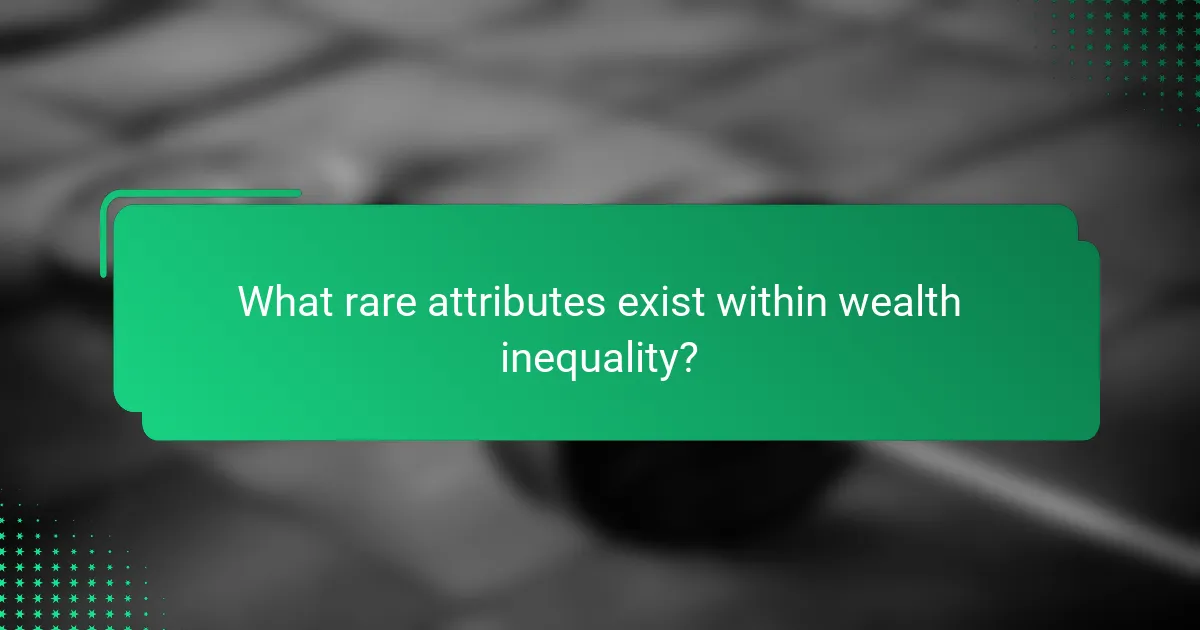
What rare attributes exist within wealth inequality?
Wealth inequality exhibits rare attributes that significantly influence social dynamics. One such attribute is intergenerational wealth transmission, where wealth concentration persists across generations, creating entrenched social classes. Another rare attribute is the psychological effects on marginalized groups, often leading to feelings of hopelessness and reduced motivation. Additionally, the impact of wealth inequality on health disparities is unique; individuals in lower socioeconomic strata face increased health risks and limited access to care. These rare attributes highlight the complex interplay between wealth inequality and broader societal issues.
How do specific policies exacerbate or alleviate wealth inequality?
Specific policies can either exacerbate or alleviate wealth inequality through their structural impacts on income distribution and access to resources. For example, tax policies favoring the wealthy can widen the gap, while progressive taxation can promote equity. Social welfare programs, when adequately funded, provide support to lower-income individuals, reducing disparities. Conversely, austerity measures often cut essential services, increasing inequality. Policies targeting education and job training can empower disadvantaged groups, fostering upward mobility and mitigating wealth gaps.
What unique case studies highlight extreme wealth inequality?
Extreme wealth inequality is highlighted in case studies like the 2014 Panama Papers leak, revealing how the wealthy utilize offshore tax havens. Another example is the 2020 COVID-19 pandemic, which exacerbated existing disparities, with billionaires increasing their wealth significantly while millions faced unemployment. The 2019 World Inequality Report indicated that the top 1% owned 44% of global wealth, showcasing a stark contrast to the bottom half, which possessed less than 1%. These cases illustrate the unique psychological impact and social consequences of extreme wealth concentration.

What practical solutions can address wealth inequality?
Practical solutions to address wealth inequality include progressive taxation, enhanced access to education, and affordable healthcare. These strategies can reduce disparities by redistributing resources and providing opportunities for upward mobility. For example, implementing a wealth tax can generate revenue for social programs. Expanding vocational training can equip individuals with skills for better-paying jobs.
What are effective policy recommendations for reducing wealth inequality?
Effective policy recommendations for reducing wealth inequality include progressive taxation, improved access to education, and increased minimum wage. These measures address root causes and promote equitable wealth distribution.
1. Implement progressive taxation to ensure higher earners contribute a fairer share.
2. Enhance access to quality education, fostering skills development for low-income individuals.
3. Raise the minimum wage to provide a living wage for all workers.
4. Expand social safety nets, including healthcare and housing assistance, to support vulnerable populations.
5. Encourage affordable housing initiatives to reduce living costs for low-income families.
6. Promote financial literacy programs to empower individuals in managing their finances effectively.
How can community initiatives foster economic equity?
Community initiatives can significantly foster economic equity by addressing systemic barriers and promoting inclusive growth. These initiatives often focus on enhancing access to resources, education, and job opportunities for underrepresented groups. For instance, community development programs can provide training that equips individuals with skills needed in the workforce, thereby reducing wealth inequality.
Moreover, initiatives such as cooperative businesses allow community members to share profits and decision-making, creating a more equitable economic structure. As a result, these efforts can lead to improved social cohesion and reduced economic disparities. Ultimately, community initiatives serve as a vital mechanism for driving sustainable economic equity through collective empowerment and resource sharing.
What role do educational programs play in addressing wealth inequality?
Educational programs play a crucial role in addressing wealth inequality by providing skills and knowledge that enhance economic mobility. These programs empower individuals, particularly from disadvantaged backgrounds, to access better job opportunities. For example, statistics show that higher education levels correlate with increased earning potential, helping to bridge the income gap. Furthermore, educational initiatives can foster community development and social cohesion, which are essential for sustainable economic growth. By investing in education, societies can create a more equitable landscape that benefits everyone.
What best practices can individuals adopt to combat wealth inequality?
Individuals can adopt several best practices to combat wealth inequality. Supporting local businesses fosters community growth and job creation. Advocating for fair wages ensures that workers receive adequate compensation. Engaging in financial literacy programs empowers individuals with knowledge about wealth management. Participating in community initiatives promotes equitable access to resources. Supporting policies aimed at wealth redistribution can create a more balanced economic environment.
What common mistakes should be avoided in addressing wealth inequality?
To address wealth inequality effectively, avoid common mistakes such as oversimplifying the issue, neglecting systemic factors, and ignoring diverse perspectives. Oversimplification leads to ineffective solutions that fail to address root causes. Systemic factors, like institutional racism and economic policies, should not be overlooked as they perpetuate inequality. Additionally, excluding voices from marginalized communities can result in solutions that do not meet their needs. Engaging in comprehensive dialogue and considering multifaceted approaches are crucial for meaningful progress.
How can grassroots movements influence change in wealth distribution?
Grassroots movements can significantly influence wealth distribution by mobilizing communities, raising awareness, and advocating for policy changes. These movements often highlight the psychological impact of wealth inequality, fostering a collective identity among participants. For example, campaigns focused on equitable tax policies can lead to legislative reforms that redistribute wealth more fairly.
Additionally, grassroots organizations can leverage social media to amplify their message, reaching a broader audience and attracting support. This increased visibility can pressure decision-makers to prioritize wealth equity in their agendas. The unique attribute of grassroots movements lies in their ability to connect personal stories to systemic issues, making the consequences of wealth inequality more relatable and urgent.
As a result, these movements not only challenge existing power structures but also promote innovative solutions that address the root causes of wealth inequality. Their influence can lead to lasting social change, fostering a more equitable distribution of resources within society.
